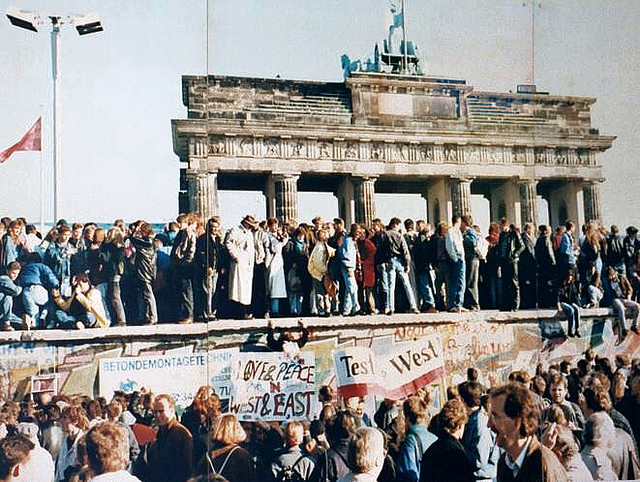Book Review: Mobilizing for Democracy: Comparing 1989 and 2011 by Donatella Della Porta
This volume aims to look at episodes of democratization through the lens of social movement studies. With case studies focused on Central Eastern Europe in 1989 and in the Middle East and North Africa in 2011, Donatella Della Porta presents theories on causal mechanisms and conditions as they emerge in mobilizations for democracy. This is an exhaustive and empirically rich work that will attract readers interested in learning more about the role of those ‘from below’ in democratization and the dynamics of protests, writes Asma Ali Farah. It is only a pity that on some occasions, the author does not substantiate her thought-provoking claims with more solid evidence.

The Fall of the Berlin Wall. Credit: Daniel Antal, CC BY 2.0
Mobilizing for Democracy: Comparing 1989 and 2011. Donatella Della Porta. Oxford University Press. March 2014.
The onset of the unforeseen yet inevitable turmoil in the Middle East in late 2010 sparked an ever-increasing literature on the origins, dynamics and implication of the Arab insurrections at the national, regional and international level. Numerous academic events such as workshops and conferences have been organised to better disentangle the recent political developments in the affected Middle Eastern countries. One popular method of making sense of these spontaneous popular movements has been to resort to historical framing to find parallels with past transformative mass uprisings. As a consequence, the Arab revolts have been likened to the revolutions in Eastern Europe in 1989 and the Prague Spring of 1968 – from where the term ‘Arab Spring’ borrowed its name.
Donatella Della Porta – an established scholar in social movement studies who has also written extensively on political violence and terrorism – has not remained unaffected by this latest trend, for as the title makes explicit, Mobilizing for Democracy: Comparing 1989 and 2011 adopts a historical comparative approach to systematically investigate the circumstances and processes that enable ‘democratization from below’, or democratic reforms moved by non-institutional actors. Although the volume most exhaustively considers ‘eventful democratization’ – protest-driven democratic change- mention is also made of episodes during which social movements exert less pull on the outcome of protest, such as ‘participated pacts’ – in which social movements bargain with institutional actors – and ‘disruptive coups’ – in which elites manipulate and appropriate mass protest.
However, this work should not be taken as just another comparative endeavour, as it makes a number of significant contributions. Firstly, it enriches the fields of democratization and social movement studies by investigating how agency and structural constraints interact in episodes of mass mobilization that precede liberalization. Secondly, it rigorously extricates the common mechanisms that facilitated two different waves of protests, permitting the building of a model on the characteristics and dynamics of eventful democratization. Thirdly, it is empirically rich: while eventful democratization in the German Democratic Republic, Czechoslovakia, Tunisia, and Egypt occupy centre stage, the discussion extends to Hungary, Poland, Morocco, Yemen and Turkey, to analyse participated pacts, and Romania, Albania, Libya, and Syria, to examine instances of participated coups d’états. Furthermore, the volume is all-inclusive, for in addition to addressing the usual suspects in social movement studies – framing, mobilizing structures, opportunities, violence and repression – it also considers more marginal topics, such as the role of nationalism in mobilizing both for and against democracy.
Mobilizing for Democracy possesses a detailed theoretical framework that seeks to explain why mobilization from below produces different outcomes. In Figure 10.3 (p. 297), Della Porta presents three models – based on the degree of political opportunities present to protesters and social movements, and their mobilization of resources – to explain under what circumstances eventful democratisation, participated pacts, and ‘troubled democratization’ occur. The first outcome can be observed when the authorities fail at repression and split, and when there is a vibrant civil society and the utilisation of ‘democratization frames’. The second phenomenon happens when there is limited repression, bargaining, and split between the elite before the protest spreads, coupled with the existence of a civil society and the utilisation of democratic discourses. Finally, the third process takes place when there is strong repression, split in the military, and a weak civil society with limited use of democratic frames.
—
Note: This review was originally posted on LSE Review of Books. It represents the views of the author and does not give the position of Democratic Audit or the LSE. Please read our comments policy before responding.
—
Asma Ali Farah is is a PhD candidate at the Department of Politics and International Relations, at Royal Holloway, University of London. She holds an MSc in International Relations from Royal Holloway. Her research interests include political participation, political representation, government responsiveness to protest, and women’s rights. Read more reviews by Asma on LSE Review of Books.





 Democratic Audit's core funding is provided by the Joseph Rowntree Charitable Trust. Additional funding is provided by the London School of Economics.
Democratic Audit's core funding is provided by the Joseph Rowntree Charitable Trust. Additional funding is provided by the London School of Economics.
Book Review: Mobilizing for Democracy: Comparing 1989 and 2011 by Donatella Della Porta https://t.co/nQ8B7YSbTE
Book Review: Mobilizing for Democracy: Comparing 1989 and 2011 by Donatella Della Porta https://t.co/qZnrPqknMo